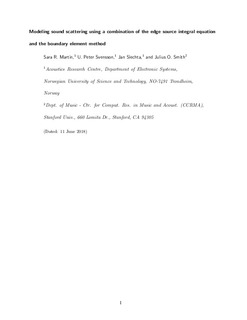| dc.contributor.author | Martin Roman, Sara-Regina | |
| dc.contributor.author | Svensson, U. Peter | |
| dc.contributor.author | Slechta, Jan | |
| dc.contributor.author | Smith, Julius O. | |
| dc.date.accessioned | 2019-03-06T12:54:47Z | |
| dc.date.available | 2019-03-06T12:54:47Z | |
| dc.date.created | 2018-12-20T11:54:14Z | |
| dc.date.issued | 2018 | |
| dc.identifier.citation | Journal of the Acoustical Society of America. 2018, 144 131-141. | nb_NO |
| dc.identifier.issn | 0001-4966 | |
| dc.identifier.uri | http://hdl.handle.net/11250/2589024 | |
| dc.description.abstract | A hybrid method for sound scattering calculations is presented in this paper. The boundary element method (BEM) is combined with a recently developed edge source integral equation (ESIE) [J. Acoust. Soc. Am. 133, 3681–3691 (2013)]. Although the ESIE provides accurate results for convex, rigid polyhedra, it has several numerical challenges, one of which applies to certain radiation directions. The proposed method, denoted ESIEBEM, overcomes this problem with certain radiation directions by applying a similar approach as BEM. First, the sound pressure is calculated on the surface of the scattering object using the ESIE, and then second, the scattered sound is obtained at the receiver point using the Kirchhoff-Helmholtz boundary integral equation, as BEM does. The three methods have been compared for the scattering by a rigid cube. Based on results from several discretizations, ESIE and ESIEBEM results are typically (90% quartile) within 3–4 · 10−4 for a kL-value of 1.83 and 2 · 10−3 for kL = 9.15, L being the cube length, of reference results computed with the BEM. The computational cost of ESIEBEM appears to be lower than BEM. | nb_NO |
| dc.language.iso | eng | nb_NO |
| dc.publisher | Acoustical Society of America | nb_NO |
| dc.title | Modeling sound scattering using a combination of the edge source integral equation and the boundary element method | nb_NO |
| dc.type | Journal article | nb_NO |
| dc.type | Peer reviewed | nb_NO |
| dc.description.version | acceptedVersion | nb_NO |
| dc.source.pagenumber | 131-141 | nb_NO |
| dc.source.volume | 144 | nb_NO |
| dc.source.journal | Journal of the Acoustical Society of America | nb_NO |
| dc.identifier.doi | 10.1121/1.5044404 | |
| dc.identifier.cristin | 1646148 | |
| dc.relation.project | Norges forskningsråd: 240278 | nb_NO |
| dc.description.localcode | © 2018. This is the authors' accepted and refereed manuscript to the article. The final authenticated version is available online at: https://doi.org/10.1121/1.5044404 | nb_NO |
| cristin.unitcode | 194,63,35,0 | |
| cristin.unitname | Institutt for elektroniske systemer | |
| cristin.ispublished | true | |
| cristin.fulltext | postprint | |
| cristin.qualitycode | 2 | |
